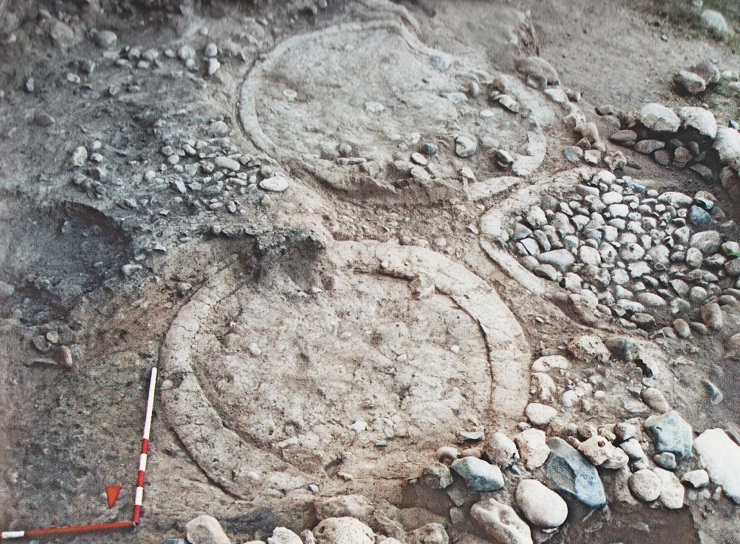|
|
| Many of the Turkish sites vanished during the frequently spontaneous development of urban architecture. Tel Yumuktepe now lies within the city of Mersin, which currently has a total number of a million inhabitants, while a significant number of the prehistoric sites were ruined by the glitzy establishment of the City Park. Current research is seeking to decipher some extremely complicated finding situations, for example in the former interior of a house dating from an earlier phase of the Neolithic settlement. The Head of Research Isabella Caneva is investigating site of Yumuktepe for more than 20 years. Photo by Jaroslav Řídký 2014. |
The Yumuktepe site is one of the oldest known sites in Anatolia and had already been examined prior to the Second World War. An almost 11-metre thick Neolithic layer that originated by levelling residential terraces during the reconstruction period suggests the long-term use of this settlement area with its excellent location for exploiting the raw material resources of Central Turkey (e.g. obsidian) and of the Levant.
It is very likely that the local settlement is related to the changes that took place at the end of the Pre-Pottery Neolithic period (i.e. at the end of the 8th millennium BC), when large-scale agglomerations ceased to exist and instead there was a shift of the settlement space to other new areas, especially those that happened to be located along the Mediterranean coast. At the beginning of the 7th millennium BC several settlements were established on the shore of the Mediterranean Sea that were focused particularly on cattle breeding and on fishing. Both the pottery and the architecture indicate the strong inter-regional ties that existed with the Levant, while, on the other hand, the Yumuktepe site is interesting in regard to its occupants’ utter ignorance of the local resources; it was as if they were local residents who were trying to emphasise their group identity in a completely new environment. Also documented in the oldest Neolithic layers was a notable quantity of obsidian artefacts, which were apparently in the form of blade blanks that had been imported to this site. Throughout the entire period of the Neolithic settlement there was a noticeable link to the Eastern Mediterranean Coast (e.g. stone sealers). Gradually, however, the use of local raw materials and crop production began to prevail. These evident changes also took place in regard to the construction technology, whereby daubed wicker structures were gradually replaced by stone architecture - during the Late Neolithic phase a massive wall was erected there, together with a path paved with stones. Large-scale clay objects that were used for food storage have been documented there, together with a number of specialised activities – the production of items from bones and the production of stone tools and of jewellery.
 |
| The Neolithic architecture along the southern coast of Turkey differs quite significantly from that of the South Turkey and the Central Turkey traditions. Captured in the photo are the stone foundations of individual rectangular buildings dating from a mid-construction phase during the Neolithic period. Modified and adapted from Caneva - Köroğlu 2010, Fig. 34. |
|
|
|
Storage objects represent some of the principle attributes of the Neolithic period. The Yumuktepe site is well known thanks to these remnants of massive surface storage structures made of burnt clay. Modified and adapted from Caneva - Köroğlu 2010, Fig. 43. |
Want to learn more?
- Caneva, I. 2012. Mersin-Yumuktepe In the Seventh Millenium BC: an updated view. In The Neolithic in Turkey. New Excavations & New Research, eds. M. Özdogan, N. Başgelen, and P. Kuniholm, 1–29. Istanbul: Archaeology & Art Publications.
- Caneva, I., and G. Köroğlu. 2010. Yumuktepe – a Journey through Nine Thousand Years. Istanbul: Ege Yayinlari.
- Simmons, A. H. 2010: The Neolithic Revolution in the Near East: Transforming the Human Landscape. Tucson: University of Arizona Press, 184-194.
 Archeologické 3D virtuální muzeum
Archeologické 3D virtuální muzeum

.jpg)

